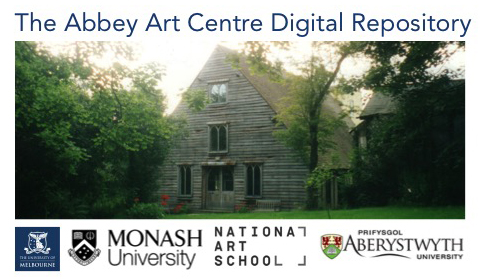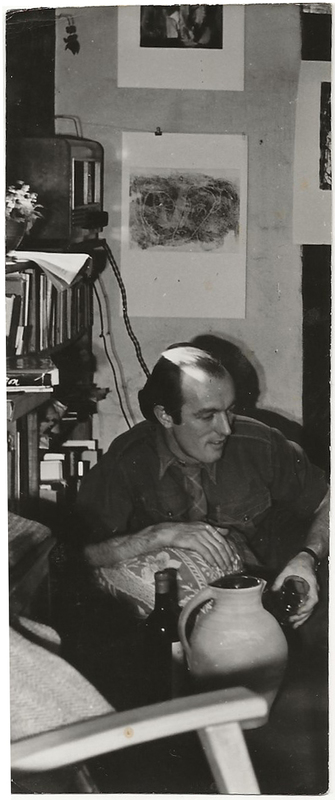Douglas Allan Green (1921–2002)
Identifier
Title
Type
Contributor
Birth Date
Birthplace
Death Date
Place of death
Occupation
Biography
Douglas Allan Green studied at the Melbourne Technical College (MTC, later renamed RMIT) under watercolourist John Rowell (1894–1973) and printmaker Murray Griffin before WW2.
Green worked as a cartographer in the AIF during World War 2. In March 1941, at age 20, he enlisted at Royal Park in the AHQ (Army Headquarters) Cartographic Company. His occupation was given as commercial artist and he had by then completed six years of study at the 'School of Applied Art' [Working Man's College, Melbourne, now RMIT, 1937–41]. Throughout 1941 he was in camp in Melbourne and Caulfield. In December that year he was transferred the 2/1 Corps Field Survey Company and sent to Echuca, on the New South Wales border. He was back in Melbourne in January, before being transferred in April 1942 north to Darwin. He arrived two months after the Japanese first bombed Darwin in the largest single air raid in Australia's history and was present during subsequent smaller air raids on Darwin including that of 16 June 1942, when ships in Darwin Harbour were destroyed.
Leaving Darwin in June 1943, he was initially sent south to New South Wales before joining the 2nd/1st Australian Army Topographical Survey Company in Queensland in September 1943. For fifteen months he was stationed in north Queensland. Portrait sketches of Indigenous people from Atherton and a VADs nurse near Kuranda exist from this time.
With the Topographical Survey Company he sailed in December 1944 on the SS Jean-Pierre Chouteau from Townsville to Hollandia, near Jayapura, in what was then known as Dutch New Guinea (now Papua, Indonesia). A series of sketches from the army camp at Lake Sentani, near Jayapura, exist from this time and are in the collections of AWM and MAGNT. Promoted to the rank of Corporal, he transferred in June 1945 to the 1st Australian Mobile Lithographic Section at Morotai. As Charles Green later wrote: 'Along with a group of other young Australian artists, he moved from island to island with General McArthur’s command, just behind the front line, making the maps each night that bombers used next day' (artist's statement, Gagprojects, Kent Town, South Australia, 2010). After eight months in Papua New Guinea he was flown to Manila, for two months, just after the US had liberated the Philippine capital.
In October 1945 he returned by plane to Melbourne, where he joined the Design Division in East Malvern. There he met fellow artist Grahame King, with whom he would later share a studio at the Abbey and travel with through England and France. He was discharged from the army in April 1946.
Back in Melbourne, he studied under George Bell, 1946–47, and enrolled at the National Gallery School with the returned serviceman’s stipend that assisted many artist-returned soldiers into art schools at that time. At the completion of that Diploma, during which he shared studios with John Brack, he entered and won the famous Murdoch Travelling Fellowship; this was very controversial since Melbourne’s realist/tonalist community was enraged (the other finalist was tonalist AME Bale). Green’s winning work was the first modernist painting to win this award; it reflected both his close study of worked in the NGV collection, and in particular the recently acquired unfinished large painting by Veronese.
Green departed Melbourne 10 June 1948 on the Fort Cologne, a cargo boat operated by McIlwraith McEacharn Ltd. One of the partners in the firm, the Scotsman Captain Neil McEacharn, had a substantial collection of Australian modern art (notably the work of Dobel), amassed during the war. Green carried a letter of introduction to McEacharn and would later visit McEacharn at his renowned Villa Taranto, on the shores of Lake Maggiore, with his wife Helen in 1950, a short stay at which McEacharn’s friend, painter Donald Friend, was also present, working on a commission to document the flowering of a rare plant for the magnate.
In London he settled at the Abbey Art Centre, where his Melbourne friends Max Newton, Grahame King, and Peter Graham were already resident. From mid-1948 until 1950 he studied under Bernard Meninsky at the London City Council School of Arts and Crafts (later called the Central School of Arts and Crafts). In his travels across ruined Europe, accompanied by different friends, he encountered the great Romanesque cathedrals of France and Italy, which had a transformative and galvanising effect on him. He was also deeply affected by his encounters with Irish modernist Gerard Dillon, whom he and Helen visited in Ireland. He maintained close friendships with several artists from The Abbey circle, including artists who were not resident but whose stay in London coincided with his, for the rest of his life, including the Kings, Grahame and Inge, and Michael Shannon (who he had met around the time of his National Gallery studies), and Peter Graham.
On returning to Australia, the Greens moved into Helen’s parent’s beachouse at 2 Newington Lane, Chelsea (a then completely undeveloped string of semi-isolated beach-shacks) and he worked in advertising and design, in a partnership with Grahame King. During this period he was commissioned to create a mosaic for a new, modernist church in Balwyn. When the new Bonbeach High School opened in 1957 [or 1958?], he decided to retrain as a secondary school teacher. First he needed to upgrade his qualifications, so he gained his Diploma of Art at RMIT in 1960 with a folio of drawings completed at RMIT as well as a group of new paintings he had commenced in 1959 including the Schoolyard painting now in the NGV collection.
He joined the Victorian Education Department as a part-time art teacher at the new Bonbeach High School (c. 1957/58), where Helen Green was already working fulltime (she gained her teaching qualifications after graduating with an Honours degree at Melbourne University during wartime; she worked in small rural schools up until she sailed to the UK to join Douglas; when she returned to teaching in the later 1950s, Douglas became the carer for their three young children).
Later solo exhibitions include Meditations on a blue-gum (coloured pen drawings, Murphy Street Print Room, South Yarra, Vic., 8–24 April 1975), marking his return to an intensive studio practice. He exhibited twice at the legendary Pinacotheca Gallery, Richmond, introduced to gallerist Bruce Pollard by his son Charles Green, an exhibiting artist at the gallery; these shows were The Ten Thousand Heavenly Clouds, or Sunset and the You Yangs: watercolours by Douglas Green, Pinacotheca, Richmond, Vic., 22–28 June 1986 (a tribute to framer Les Hawkins, who loaned Green his books on JMW Turner just the day before his death; these paintings in an elongated horizontal scroll format drew on close observation of the sunset skies throughout the year from his Chelsea residence, which he had recently moved from at the time of the Pinacotheca show); and A Solstice Cycle: The Ten Thousand Heavenly Clouds & The Ten Thousand Earthly Trees, Pinacotheca, Richmond, Vic., 14 June – 1 July 1989 (a series of twelve gouache vertical scroll-like works on paper, each representing a different month of the year, and each taking as its motif Mount Alexander and its foothills observed from the outskirts of Castlemaine, where he had recently settled after his wife Helen retired; they had been resident in Bendigo from 1977 to 1985). The Lyttleton Gallery, North Melbourne, held a survey of his early works from the 1940s and 1950s, including war time works on paper and postwar travel observations, in 1994.
Green also took part in several group shows, particularly at the Castlemaine Art Gallery including their 9x5 Centenary Exhibition (5–27 August 1989) and then at the Ballarat Regional Art Gallery, for Ten Regional Artists(13 October – 3 November 1991). He was awarded the Dominique Segan Drawing Prize at the Castlemaine Art Gallery in the 1990s.
Bibliography
Douglas Green: oil paintings and works on paper from 1942 to 1962, North Melbourne: Lyttleton Gallery, 30 July –18 August 1994.
Christopher Heathcote, 'A post-war rebel without a cause', The Age, Melbourne, 3 August 1994, p. 22;
Christopher Heathcote, A Quiet Revolution: The Rise of Australian Art 1946–1968, Melbourne: Text Publishing, 1995, pp. 10–12, plate 1.

